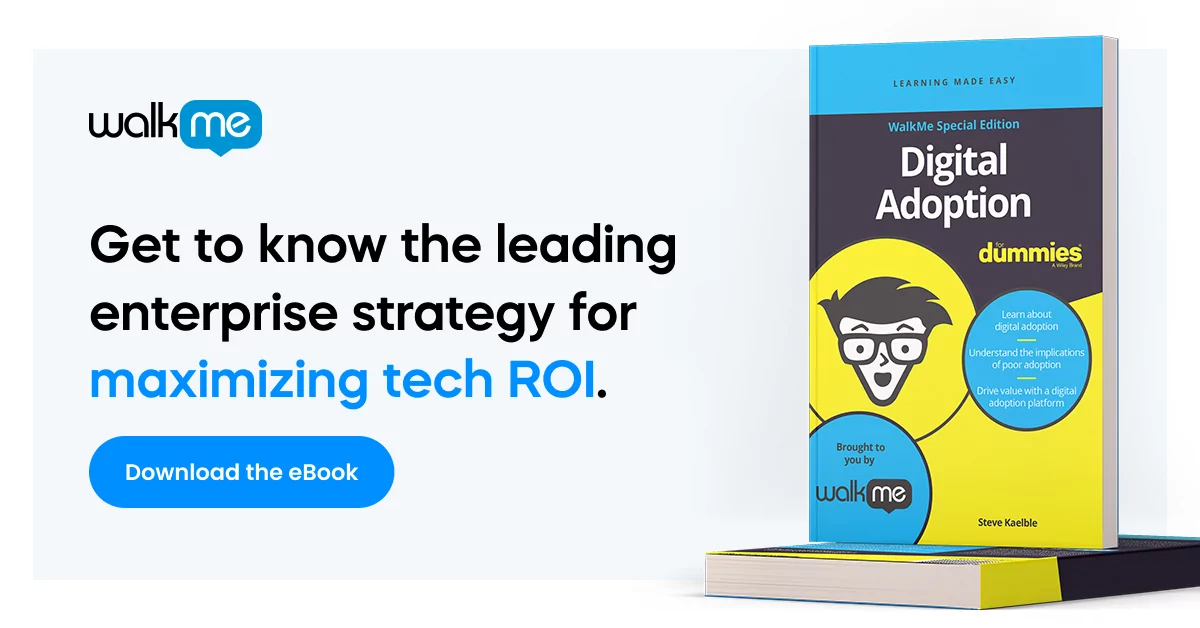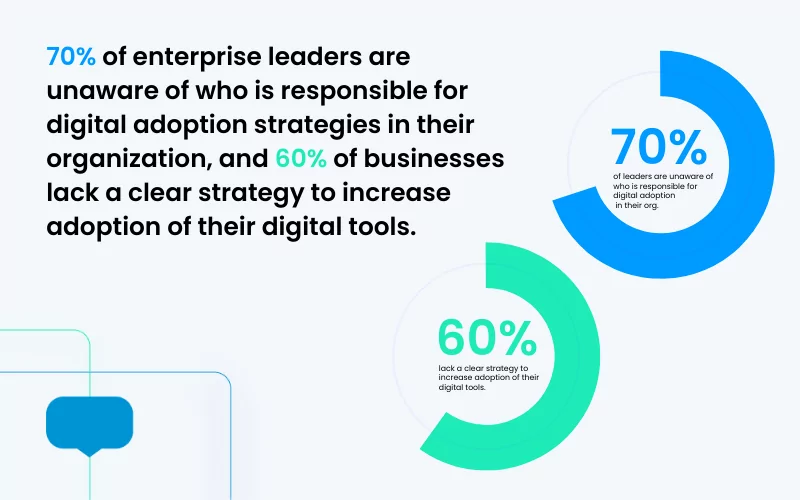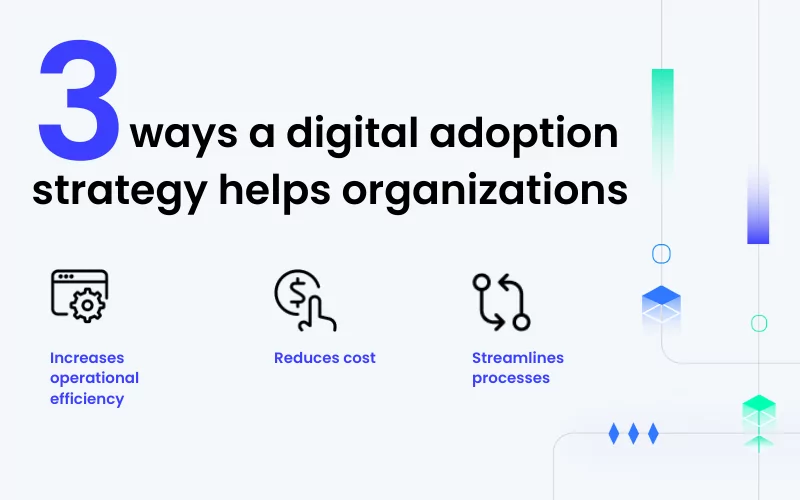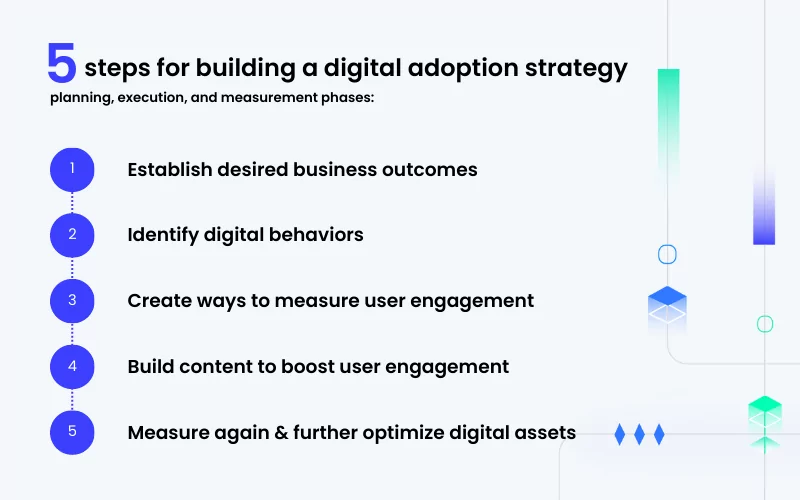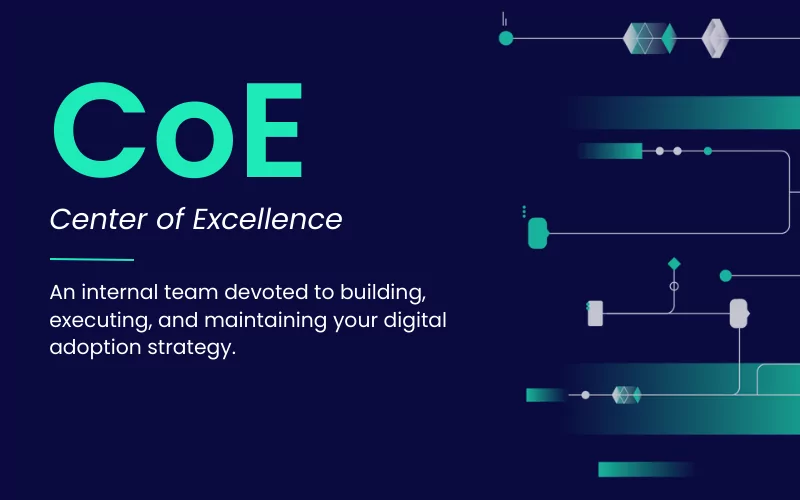An effective digital adoption strategy can help you boost employee productivity, increase software ROI, streamline change management programs, and much more. Creating that strategy, however, requires careful planning, team building, and optimization processes – steps that many organizations are not equipped to execute.
According to WalkMe’s State of Digital Adoption 2022-2023 report, 70% of enterprise leaders are unaware of who is responsible for digital adoption strategies in their organization, and 60% of businesses lack a clear strategy to increase adoption of their digital tools.
Here, we’ll dive into the five essential building blocks for any digital adoption strategy. The processes outlined here will help you streamline your digital transformation initiatives, giving you the tools you need to maximize your digital assets. We’ll also highlight the team you will need to build to ensure your digital adoption strategy’s long term viability. But first, let’s define how digital adoption strategies help enterprises streamline their digital processes.
What is a digital adoption strategy?
A digital adoption strategy helps you maximize your technology investments while ensuring users can take full advantage of their digital assets. Typical use cases in which a digital adoption strategy can prove useful include user onboarding, change management programs, and software training.
By helping to integrate new digital systems, processes and tools into daily operations, a digital adoption strategy helps organizations:
- Increase operational efficiency – Empowering employees to fully use their software capabilities reduces time spent on dealing with support tickets, navigating irrelevant application features, and learning about new programs.
- Reduce costs – Creating custom in-app navigation and guidance, saves money and time on things like training, support, and employee onboarding.
- Streamline processes – Enabling users to quickly navigate through applications while providing them with the content they need to complete tasks effectively helps optimize workflows.
In addition to guiding users on how to utilize new and existing software, a digital adoption strategy monitors how applications are being used, identifies friction points, and notes areas for improvement. This allows you to make data-driven decisions about optimizing the use of these technologies in order to maximize their effectiveness.
Building out your digital adoption strategy
Building out your digital adoption strategy can be broken down into the following five steps that span the planning, execution, and measurement phases.
1. Establish desired business outcomes.
The first step in developing your digital adoption strategy is to establish desired business outcomes and determine why they are not being achieved. Then, make sure to align your digital adoption program to your goals.
While these KPIs can and should be expanded upon, be sure to start small; one system, one persona, and two or three business processes should be enough to get going. Give you and your team time to learn about the application you would like to optimize and how a digital adoption platform (DAP) can be used to achieve your goals.
2. Identify the digital behaviors required to achieve those outcomes
Once you have outlined your desired outcomes, you will need to develop an understanding of how they can be achieved. This can be done by looking at how your employees are using their digital tools and to what end.
Tools like funnels and tracked events should be used to measure user experience, including digital friction points, from which an initial baseline can be created. This data will indicate the content that needs to be developed on your DAP and where to put it.
3. Create ways to look at and measure user engagement
When measuring your digital adoption strategy, looking at things like ticket completion rates and time spent in an application are important, but they don’t get to the heart of digital adoption.
Instead, look at the employee digital experience and their behavior within the application. Digital adoption is about getting employees to use software to its fullest potential, so be sure to measure the ways to make that possible.
4. Build content to boost user engagement
Based on the lessons learned, your next step is to build content that can be delivered in a digital experience within an application. This content can take many forms, including smart walkthroughs, contextual guidance, and in-app support.
It is important to take into account the different types of employees and departments that will be using the content in your DAP, and to personalize it as much as possible. If, for example, your marketing and sales teams are both working towards the same KPI, the content in your DAP will need to be customized for both audiences.
5. Measure again and further optimize digital assets
Digital adoption strategies need to be continuously fine tuned to meet the changing needs of your organization. Develop a continuous workflow, in which you measure how employees interact with your DAP to ensure they are learning the right digital behaviors.
As you expand your digital transformation efforts or alter your desired business outcomes, the way you use your DAP will change. Be sure that your digital adoption strategy evolves along with your enterprise goals.
Maximizing your digital adoption strategy with a center of excellence (CoE)
A center of excellence (CoE) is an internal team devoted to building, executing, and maintaining your digital adoption strategy. Your team should consist of existing employees from different departments who are already engaged with the digital experience.
In addition to managing your digital adoption strategy, the CoE should focus on educating the different departments within your enterprise on your DAP solution. Giving everyone in your organization some knowledge about DAP enables teams to develop application specific content to further their digital transformation goals.
Specific roles within the team can include:
- Learning and development experts
- Business analysts
- Content managers
- Project managers
- Change management specialists
- Manufacturing operations
- Translation services
- IT developers
When building your CoE, it’s important to embrace your enterprise’s organizational diversity. Don’t be afraid of recruiting people from different parts of your organization and putting them together to grow the team.
The bottom line is that developing an effective digital adoption strategy doesn’t require investing a lot of money and hiring a new team. Take advantage of the resources at your disposal and grow as needed.
Why WalkMe?
As the only enterprise-ready DAP, WalkMe enables organizations to rapidly scale up their digital transformation efforts while staying agile when onboarding new software. With a variety of digital adoption tools, like custom dashboards that provide visibility across entire tech-stacks, a partner ecosystem that provides tips and best practices to increase adoption, and extensive personalized training, we give you the ability to maximize your digital technologies.
WalkMe is recognized by leading research firms, including Everest Group which recently recognized us as the leading DAP vendor for the third year in a row, and The Forrester New Wave™ Digital Adoption Platforms, Q4 2022, which named us a Leader in DAP.
Learn more about developing your own digital adoption strategy to better utilize your digital tools with WalkMe today.
